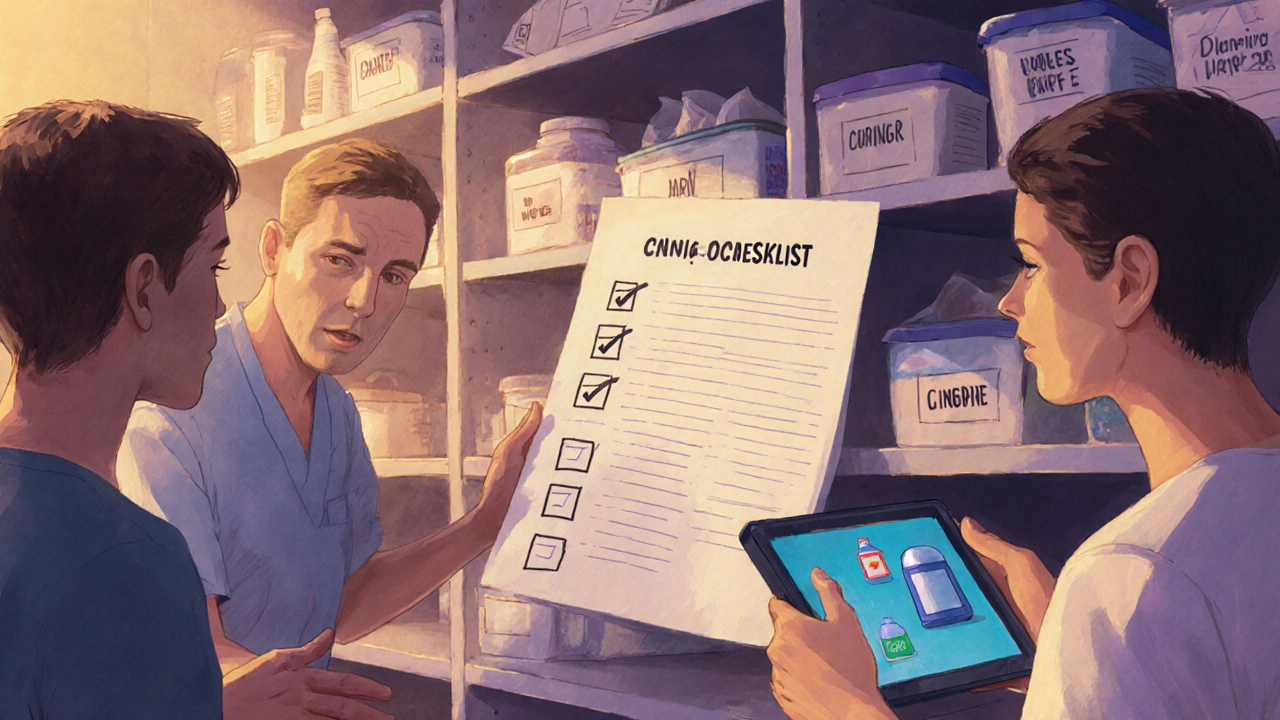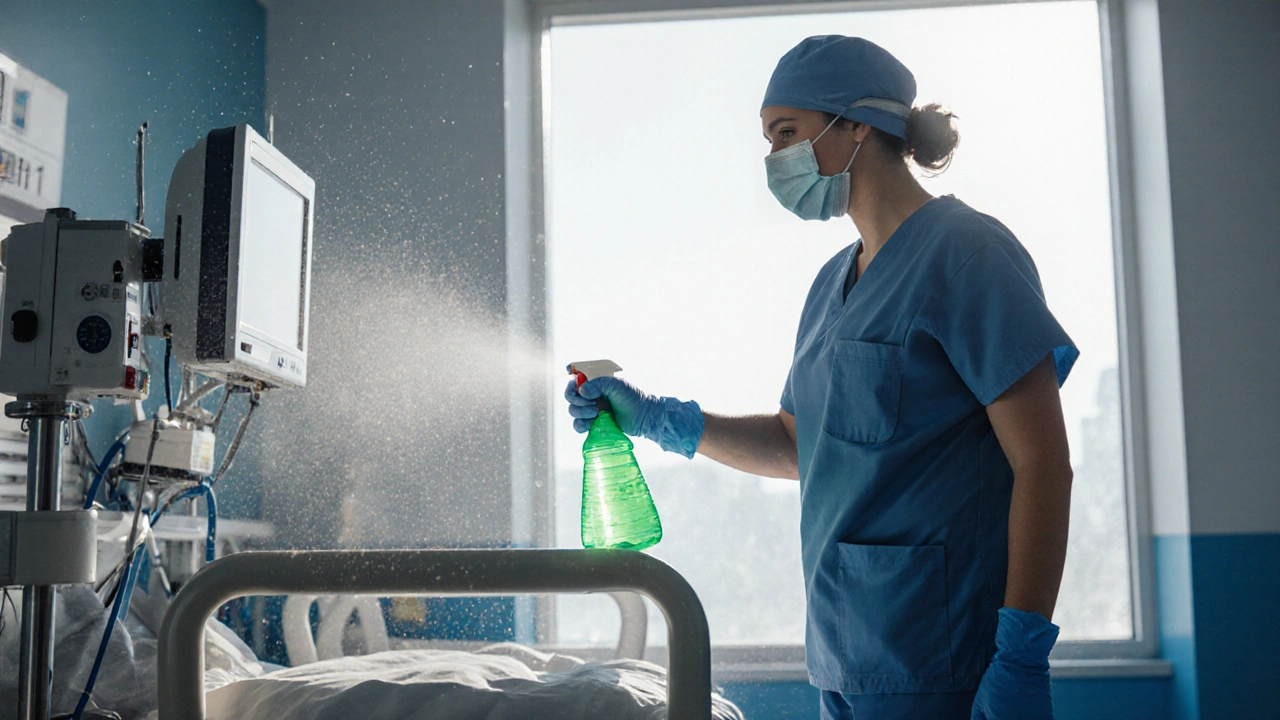Candida Disinfection Calculator
This tool helps determine the appropriate disinfectant concentration and contact time needed to effectively eliminate Candida species from hospital surfaces.
When a patient’s blood culture suddenly lights up with yeast, the alarm bells ring for candidemia-a bloodstream infection that can spread to the heart, eyes, and brain. The odds of catching it often hinge on something you barely see: the cleanliness of the surrounding surfaces. Below you’ll find a practical rundown of why environmental cleaning matters, which cleaning steps matter most, and how hospitals can turn a clean room into a safety net.
Quick Summary
- Candidemia and disseminated Candida infections thrive on contaminated surfaces and medical equipment.
- Rigorous environmental cleaning cuts the pathogen load and interrupts transmission.
- Use a tiered cleaning protocol: routine daily cleaning, terminal cleaning after patient discharge, and outbreak‑specific deep disinfection.
- Effective agents include chlorine‑based solutions (≥1000ppm), hydrogen peroxide vapor, and EPA‑registered quaternary ammonium compounds.
- Monitoring with ATP bioluminescence or fungal cultures validates cleaning effectiveness.
Understanding Candidemia and Disseminated Candida Infections
Candidemia is a bloodstream infection caused by Candida species that can quickly disseminate to vital organs, leading to high mortality rates, especially in intensive‑care settings. When Candida moves beyond the bloodstream, it can cause disseminated Candida infection a systemic spread affecting the kidneys, eyes, liver, and central nervous system, often requiring prolonged antifungal therapy. The most common culprits are Candida albicans and non‑albicans species like C. glabrata, C. auris, C. parapsilosis, each with varying resistance patterns.
These infections are classified as healthcare‑associated infections (HAIs) infections that patients acquire while receiving treatment for other conditions in a healthcare facility. According to the latest CDC surveillance, Candida accounts for roughly 8% of all HAIs in intensive‑care units, and the mortality can exceed 40% when treatment is delayed.
Why the Environment Plays a Pivotal Role
Candida thrives on moist, nutrient‑rich surfaces-think sink drains, ventilator tubing, and even the seams of mattress covers. Studies using molecular typing have traced outbreak strains back to a single bedside table or a reusable ultrasound probe. The fungus can persist for weeks on inanimate objects, forming biofilms that resist routine cleaning.
Infection control teams now view the hospital environment all surfaces, equipment, and air within patient care areas that can harbor microorganisms as a reservoir that fuels transmission. Reducing that reservoir means fewer opportunities for Candida to enter a vulnerable patient’s bloodstream through lines, catheters, or broken skin.
Key Elements of an Effective Environmental Cleaning Program
Successful programs combine three layers: a clear disinfection protocol a documented set of steps, agents, contact times, and validation methods for cleaning patient‑care areas, trained staff, and ongoing performance monitoring.
- Risk‑based cleaning frequency. High‑touch surfaces (bed rails, call buttons, infusion pumps) get cleaned at least twice daily; low‑touch areas receive daily wipes.
- Agent selection. Choose products that meet EPA’s ListN for Candida. Chlorine‑based solutions (1000-5000ppm) are fast‑acting and cost‑effective, while hydrogen peroxide vapor is excellent for terminal cleaning of rooms after a severe outbreak.
- Contact time. Follow manufacturer‑specified dwell times-usually 5minutes for chlorine, 10minutes for quaternary ammonium compounds.
- Cleaning technique. Use a two‑step method: first remove visible soil with a detergent, then apply the disinfectant. Microfiber cloths retain moisture longer, improving efficacy.
- Verification. Employ ATP bioluminescence meters for rapid surface cleanliness checks and periodic fungal cultures for high‑risk zones.

Comparing Common Disinfectants for Candida Control
| Disinfectant | Active Ingredient | Concentration | Contact Time | Pros | Cons |
|---|---|---|---|---|---|
| Chlorine‑based | Sodium hypochlorite | 1000-5000ppm | 5min | Broad‑spectrum, inexpensive | Corrosive to metal, strong odor |
| Quaternary ammonium | Quat salts | 0.1-0.2% | 10min | Non‑corrosive, compatible with most surfaces | Variable efficacy against spores, may need higher concentration |
| Hydrogen peroxide vapor | H₂O₂ | 35% (vaporized) | 30-60min (room cycle) | Penetrates biofilms, leaves no residue | Equipment‑intensive, longer downtime |
Implementing a Cleaning Checklist for Frontline Staff
A concise checklist turns protocol into habit. Below is a ready‑to‑print version that you can post in every patient‑room closet.
- Gather supplies: disposable gloves, microfiber cloth, detergent, chosen disinfectant, timer.
- Wear gloves and perform hand hygiene before entering the room.
- Remove visible soil with detergent‑soaked cloth; focus on IV poles, bedside tables, and equipment keyboards.
- Rinse cloth, soak in disinfectant at the correct concentration.
- Wring out excess liquid-cloth should be damp, not soaking.
- Wipe each high‑touch surface, ensuring full coverage.
- Maintain a 5‑minute contact time; set a timer.
- Dispose of used cloths in the designated biohazard container.
- Record completion on the room’s cleaning log and note any spills or broken equipment.
Monitoring Success and Adjusting the Strategy
Even the best protocol can slip without data. Combine quantitative and qualitative monitoring:
- ATP readings. Aim for <150RLU (relative light units) on high‑touch sites.
- Environmental cultures. Quarterly swabs of sinks and ventilator circuits; a threshold of <10CFU/plate is acceptable.
- Infection rates. Track candidemia incidence per 1,000 patient‑days. A downward trend after protocol rollout signals effectiveness.
If metrics stagnate, revisit agent concentration, retrain staff, or consider adding a UV‑C disinfection step for critical equipment.
Common Pitfalls and How to Avoid Them
Many facilities think “clean enough” is sufficient. Reality check:
- Skipping the detergent step. Disinfectants can’t penetrate organic matter; always clean first.
- Under‑dosing. Dilution errors dramatically reduce efficacy-use pre‑measured containers or automated dispensers.
- Inconsistent timing. Contact time is a hard rule; timers prevent shortcuts.
- Neglecting non‑patient areas. Hallways, storage rooms, and staff lounges can act as hidden reservoirs.
Future Directions: Technology Meets Hygiene
Emerging tools-real‑time PCR surface testing, RFID‑tracked cleaning supplies, and AI‑driven scheduling-promise to tighten the feedback loop between cleaning actions and infection outcomes. Hospitals that invest early often see a 30% reduction in Candida‑related HAIs within the first year.

Frequently Asked Questions
What makes Candida different from bacterial pathogens in a hospital?
Candida is a yeast, so it forms biofilms that resist many standard disinfectants. Its spores can persist on dry surfaces for weeks, whereas many bacteria die off faster without moisture.
How often should high‑touch surfaces be cleaned in an ICU?
At minimum twice daily, with additional cleaning after any patient contact or procedure that could release fluids.
Is bleach safe for all hospital equipment?
Bleach can corrode metals and damage sensitive electronics. For those items, use a quaternary ammonium product that’s EPA‑registered for Candida.
Can routine cleaning alone eliminate Candida outbreaks?
Cleaning is essential but usually works best alongside hand‑hygiene programs, antifungal stewardship, and surveillance cultures. A multi‑layered approach yields the greatest drop in infection rates.
What is the best way to verify that a surface is truly clean?
Combine ATP testing for organic residue with periodic fungal cultures. When both metrics fall below established thresholds, you have confidence in the cleaning process.


Comments (10)
People think cleaning is just about sparkle, but that's exactly what they want us to believe.
The real agenda is to hide the fact that hospitals are breeding grounds for fungal conspiracies.
By mandating surface wipes, the hidden cabal ensures that any trace of Candida gets blamed on human error, not on the systemic neglect.
So the calculator is just a smokescreen.
The paradigm of environmental decontamination is predicated upon a confluence of biocidal efficacy metrics and kinetic contact parameters.
Employing a chlorination-based matrix at a molar concentration exceeding the threshold of 0.5% engenders a mycocidal milieu commensurate with nosocomial prophylaxis.
Conversely, quaternary ammonium compounds manifest a suboptimal log-reduction in the presence of proteinaceous soiling, necessitating adjunctive mechanical abrasion.
Hence, the calculator constitutes a heuristic amalgamation of pharmacodynamic variables and temporal kinetics, facilitating a calibrated disinfection schema.
I swear the CDC is hiding something 🤯.
Every time they push a new disinfectant, there's a secret back‑door that lets the fungus slip through the cracks 🦠.
This calculator looks fancy, but you gotta wonder if they're just feeding us numbers while the real infection rates climb in the shadows.
Stay woke, clean your hands, and maybe double‑check that fogger before you trust it 😅.
Great, anothr shiny calculator nobody will actually use.
Wow, another tool that pretends to solve everything while we just keep scrubbing forever lol.
I absolutely appreciate the effort that went into assembling this interactive disinfection calculator, as it reflects a genuine commitment to patient safety.
When we consider the myriad of pathogens that can colonize hospital surfaces, Candida species occupy a particularly insidious niche that demands rigorous attention.
By providing a clear interface to input disinfectant type, concentration, and contact time, the tool empowers frontline staff to make data‑driven decisions rather than relying on guesswork.
Moreover, the inclusion of multiple chemical classes, such as chlorine‑based agents, quaternary ammonium compounds, and hydrogen peroxide vapor, acknowledges the diverse operational constraints across different care settings.
It is crucial to remember that efficacy is not solely a function of chemical potency; surface material, organic load, and ambient temperature all modulate the biocidal kinetics.
The calculator’s ability to adapt its input fields based on the selected disinfectant type is a thoughtful feature that reduces user error and streams workflow.
In addition, the visual feedback on effectiveness encourages a culture of accountability, prompting staff to verify that protocols are being adhered to in real time.
From an educational perspective, the tool can serve as a teaching aid for new hires, illustrating the quantitative relationship between concentration and contact time.
I would also suggest integrating a log‑tracking module that captures each cleaning event, thereby generating valuable data for quality improvement initiatives.
Such a repository could be cross‑referenced with infection surveillance dashboards to identify correlations between cleaning practices and candidemia incidence.
While the current version does a solid job, expanding the chemical database to include emerging agents like peracetic acid would future‑proof the platform.
Similarly, adding a prompt for personal protective equipment requirements would reinforce safety standards for the cleaning crew.
Overall, this calculator represents a meaningful step toward standardizing environmental hygiene protocols and mitigating the risk of invasive Candida infections.
I look forward to seeing how the community adopts and possibly enhances this resource, turning a simple calculation into a cornerstone of infection control.
Keep up the excellent work, and feel free to reach out if you need any collaborative testing or user‑experience feedback.
Look, i dont buy this whole 'clean everything' hype.
Sure, wipe the tables but the real problem is that we let patients walk around with catheters and think a mop will fix it.
Maybe if we stopped obsessing over surface ppm numbers and actually looked at hand hygiene, we'd see a drop.
Anyway that's just my two cents.
I’ve seen a few hospitals adopt similar calculators and the results were mixed.
The key seems to be consistent staff training rather than just the tool itself.
If the team understands why the contact time matters, they’ll follow through.
Exactly, Brian! The calculator is just a piece of the puzzle, but when you pair it with hands‑on workshops and clear signage, the compliance skyrockets.
Keep spreading the optimism!
Wow, this is just another overhyped gadget that promises miracles while we stay stuck in the same old infection nightmare!